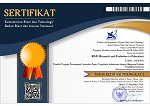Changing images of favorite schools after the student admission system reform in Indonesia
DOI:
https://doi.org/10.21831/reid.v10i2.77035Keywords:
school labeling, favorite school, student admission, school zoningAbstract
References
Akabayashi, H., & Naoi, M. (2019). Subject variety and incentives to learn: Evidence from public high school admission policies in Japan. Japan and the World Economy, 52, 1–13. https://doi.org/10.1016/j.japwor.2019.100981
Ardi, A., Danil, M., Murni, D., Giastituti, N., Rusdinal, & Hervi, F. (2023). The implementation of student admission based on zoning in Indonesia: Problems, challenges, and solutions. Jurnal Kependidikan: Jurnal Hasil Penelitian dan Kajian Kepustakaan di Bidang Pendidikan, Pengajaran dan Pembelajaran, 9(3), 914–923. https://doi.org/10.33394/jk.v9i3.8632
Ariyanto, R. A., & Chamidah, N. (2021). Sentiment analysis for zoning system admission policy using support vector machine and naive bayes methods. Journal of Physics: Conference Series, 1776(1), 1–9. https://doi.org/10.1088/1742-6596/1776/1/012058
Arlinwibowo, J., Retnawati, H., Kartowagiran, B., & Mustaqim, Y. (2020). Inclusion schools in the Daerah Istimewa Yogyakarta Province, Indonesia: Regulations, facilities and aspirations of teachers. International Journal of Early Childhood Special Education, 13(1), 9–19. https://doi.org/10.9756/INT-JECSE/V13I1.211002
Ashraf, D. (2012). Parental perceptions of school quality: Contesting the notion of quality. Search of Relevance and Sustainability of Educational Change: An International Conference at Aga Khan University Institute for Educational Development, 221–252. https://ecommons.aku.edu/pakistan_ied_pdck/234
Azzizah, Y. (2015). Socio-economic factors on Indonesia education disparity. International Education Studies, 8(12), 218¬–230. https://doi.org/10.5539/ies.v8n12p218
Burgess, S., Cantillon, E., Cavallo, M., Greaves, E., & Zhang, M. (2023). School admissions in England: The rules schools choose on which pupils to admit. University of Bristol.
Cheung, K. S., Yiu, C. Y., & Zhang, Y. (2022). What matters more, school choices or neighbourhoods? Evidence from a socioeconomic based school zoning. Cities, 128, 103772. https://doi.org/10.1016/j.cities.2022.103772
Creswell, J. W., & Creswell, J. W. (2013). Qualitative inquiry and research design: Choosing among five approaches (3rd ed). SAGE Publications.
Darmaningtyas. D. (2015). Pendidikan yang memiskinkan [Impoverishing education]. Intrans Publishing.
Dharmaningtias, D. S. (2013). Penghapusan kebijakan rintisan sekolah berstandar internasional (RSBI) [Abolition of the international standard school pilot policy]. Politica, 4(2), 263–285.
Edison, E. (2012). Gugurnya kebijakan sekolah bertaraf internasional: Investasi pendidikan vs komersialisasi pendidikan [The fall of international standard school policy: Education investment vs education commercialization]. Jurnal Kebijakan dan Administrasi Publik, 16(2), 27–46.
Erlangga, R., Putri, F. P., Dhoifah, A. A., Damayanti, M. A., Tunggawijaya, W., & Rafsanjani, F. A. (2023). School zone policy system evaluation and its effects towards Indonesian education. Pedagogia Jurnal Ilmu Pendidikan, 21(1), 67–78. https://doi.org/10.17509/pdgia.v21i1.56225
Feldman, J., & Wallace, J. (2021). Costs and benefits: Scholarship students' reflective accounts of attending an elite secondary school. International Journal of Educational Research, 107, 1–10. https://doi.org/10.1016/j.ijer.2021.101748
Habiby, W. N., & Fiatin, S. N. (2019). Persepsi masyarakat dan dampak sistem zonasi untuk jenjang sekolah dasar di Kecamatan Serengan Kota Surakarta [Society's perception and impact of zoning system for primary school in Serengan Sub-district, Surakarta City.]. Profesi Pendidikan Dasar, 6(2), 225–238. https://doi.org/10.23917/ppd.v1i2.10151
Hendarman, H. (2011). Kajian terhadap keberadaan dan pendanaan rintisan sekolah bertaraf internasional (RSBI) [Study of the existence and funding of international standard school pilots]. Jurnal Pendidikan dan Kebudayaan, 17(4), 373–382.
Herry, A., Adhi, P., & Firmansyah. (2018). The effect of inequality of educational facilities, health, and road conditions toward income distribution in Central Java Province, Indonesia. E3S Web of Conferences, 73, 1–3. https://doi.org/10.1051/e3sconf/20187310014
Hofflinger, A., Gelber, D., & Tellez Cañas, S. (2020). School choice and parents' preferences for school attributes in Chile. Economics of Education Review, 74, 1–12. https://doi.org/10.1016/j.econedurev.2019.101946
Ibrahim, N. M., Osman, M. M., & Bachok, S. (2014). Public school development and planning: Parents' criteria of selecting public school in Gombak District. Procedia - Social and Behavioral Sciences, 153, 274–285. https://doi.org/10.1016/j.sbspro.2014.10.061
Istikomah, & Romadlon, D. A. (2023). Building trust and reputation: branding strategies of elite Muslim schools in Indonesia. In T. T. Y. Alabdullah, M. I. Awang, B. Sobirov, M. T. Multazam, & M. D. K. Wardana (Eds.), Proceedings of the International Conference on Intellectuals' Global Responsibility (ICIGR 2022) (vol. 750, pp. 419–425). Atlantis Press SARL. https://doi.org/10.2991/978-2-38476-052-7_46
Joko, B. S., Fajarini, C. D., Astuti, R., & Fransisca, R. (2020). Persepsi masyarakat terhadap sekolah yang dianggap favorit [Society's perception of schools that are considered favorites]. Pusat Penelitian Kebijakan.
Kurniawati, S., Suryadarma, D., Bima, L., & Yusrina, A. (2018). Education in Indonesia: A White Elephant? Southeast Asian Economies, 35(2), 185–199. https://doi.org/10.1355/ae35-2e
Lange, N., Kisgen, S., & Faix, W. G. (2023). The elite graduate school for leadership in the future. Results of a future workshop on excellent leadership education in 2030. Leadership, Education, Personality: An Interdisciplinary Journal, 5(1–2), 21–32. https://doi.org/10.1365/s42681-023-00035-6
Liu, X., Qin, F., Zhou, X., Hu, X., & Zhang, Y. (2020). Are opportunities to equalize elite high schools discriminatory? Evidence from a quasi-experimental design. Asia Pacific Education Review, 21(3), 351–364. https://doi.org/10.1007/s12564-020-09628-y
Meiklejohn, C., Hickey, A., & Riddle, S. (2024). "˜It comes with more baggage than prestige': Deferred culpability and disavowal among elite boys' school alumni. Discourse: Studies in the Cultural Politics of Education, 45(1), 29–41. https://doi.org/10.1080/01596306.2023.2224244
Meiklejohn, C., Riddle, S., & Hickey, A. (2024). "˜Everything was going to be really easy for me': Elite schooling, old boys, and transitions to university. Higher Education Research & Development, 43(1), 196–210. https://doi.org/10.1080/07294360.2023.2218800
Muttaqin, T. (2018). Determinants of unequal access to and quality of education in Indonesia. Jurnal Perencanaan Pembangunan: The Indonesian Journal of Development Planning, 2(1), 1–23. https://doi.org/10.36574/jpp.v2i1.27
Muttaqin, T., Wittek, R., Heyse, L., & Van Duijn, M. (2020). The achievement gap in Indonesia? Organizational and ideological differences between private Islamic schools. School Effectiveness and School Improvement, 31(2), 212–242. https://doi.org/10.1080/09243453.2019.1644352
Norsiah, N., & Razali, M. (1998). The location of schools in urban area: Some planning implications. Jurnal Alam Bina, 1(1), 34–41.
Ohno, R. (2019). Study on regional disparity of academic achievement in Indonesia.
Advances in Social Science, Education and Humanities Research, 258, 212–215. https://doi.org/10.2991/icream-18.2019.43
Omeje, J. C., Egwa, E. I., & Adikwu, V. O. (2016). Impact of quota system and catchment area policy on the university admissions in North Central Nigeria. SAGE Open, 6(2), 1–8. https://doi.org/10.1177/2158244016654951
Reardon, S. F., Grewal, E. T., Kalogrides, D., & Greenberg, E. (2012). Brown fades: The end of court-ordered school desegregation and the resegregation of American Public Schools. Journal of Policy Analysis and Management, 31(4), 876–904. https://doi.org/10.1002/pam.21649
Rismita, R. (2018). The implementation of tuition-free school policy using stake's countenance evaluation model. Advances in Social Science, Education and Humanities Research, 174, 514–517. https://doi.org/10.2991/ice-17.2018.110
Rohman, A., Putranta, H., & Sidik, F. (2023). Does the implementation of school zoning policies equalize the quality of education? Case study at the junior high school level. TEM Journal, 12(4), 2593–2602. https://doi.org/10.18421/TEM124-71
Samuelsson, J. (2023). Performance and history: Elite school pupils' views on assessment and their future in Sweden. Education 3-13, 51(4), 672–684. https://doi.org/10.1080/03004279.2021.1998180
Shiferaw, M., & Kenea, A. (2024). Determinants of parental school choice: A systematic review of the literature. International Journal of Indonesian Education and Teaching, 8(1), 20–34. https://doi.org/10.24071/ijiet.v8i1.7296
Simorangkir, S. T., Karnati, N., Abdullah, T., & Suhardi, M. (2019). Student culture in favorite schools. Advances in Social Science, Education and Humanities Research, 343, 364–369. https://doi.org/10.2991/icas-19.2019.75
SMERU. (2022). Impact of the school zoning system to student learning outcomes in Yogyakarta. https://rise.smeru.or.id/en/publication/impact-school-zoning-system-student-learning-outcomes-yogyakarta
Solihin, S., & Sara, R. (2021). Gaps in the education management in Indonesia that are not following existing laws in Indonesia. Proceedings of the 1st International Conference on Law, Social Science, Economics, and Education, 1–6. https://doi.org/10.4108/eai.6-3-2021.2306886
Sulistyosari, Y., Wardana, A., & Dwiningrum, S. I. A. (2023). School zoning and equal education access in Indonesia. International Journal of Evaluation and Research in Education (IJERE), 12(2), 586–593. https://doi.org/10.11591/ijere.v12i2.22488
Sulisworo, D. (2016). The contribution of the education system quality to improve the nation's competitiveness of Indonesia. Journal of Education and Learning (EduLearn), 10(2), 127–138. https://doi.org/10.11591/edulearn.v10i2.3468
Utami, A., & Ruskan, E. L. (2020). Development of decision support system for selection of yayasan alumni scholarship using MOORA method. Advances in Intelligent Systems Research, 172, 706–710. https://doi.org/10.2991/aisr.k.200424.107
Woodfield, A., & Gunby, P. (2003). The marketization of New Zealand schools: Assessing Fiske and Ladd. Journal of Economic Literature, 41(3), 863–884. https://doi.org/10.1257/jel.41.3.863
Downloads
Published
How to Cite
Issue
Section
Citation Check
License
The authors submitting a manuscript to this journal agree that, if accepted for publication, copyright publishing of the submission shall be assigned to REID (Research and Evaluation in Education). However, even though the journal asks for a copyright transfer, the authors retain (or are granted back) significant scholarly rights.
The copyright transfer agreement form can be downloaded here: [REID Copyright Transfer Agreement Form]
The copyright form should be signed originally and sent to the Editorial Office through email to reid.ppsuny@uny.ac.id

REID (Research and Evaluation in Education) by http://journal.uny.ac.id/index.php/reid is licensed under a Creative Commons Attribution-ShareAlike 4.0 International License.







.png)





